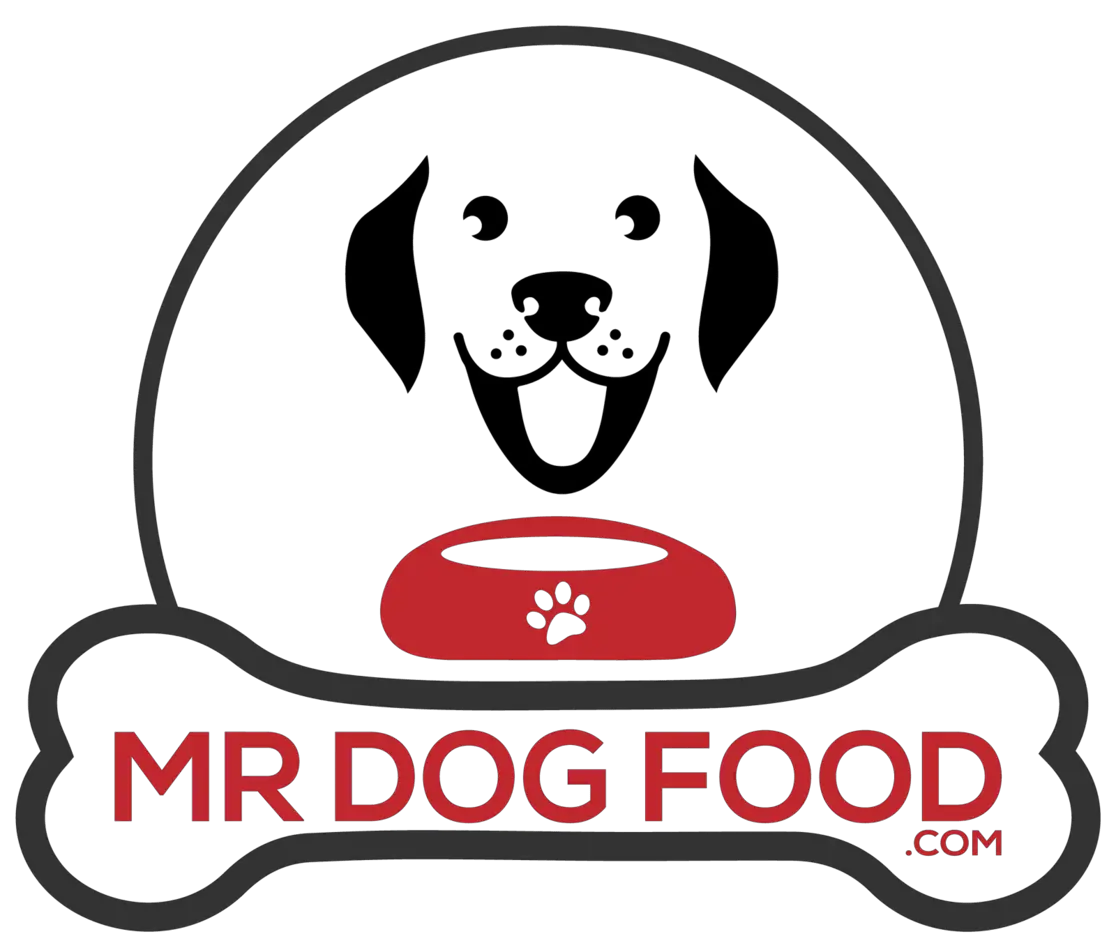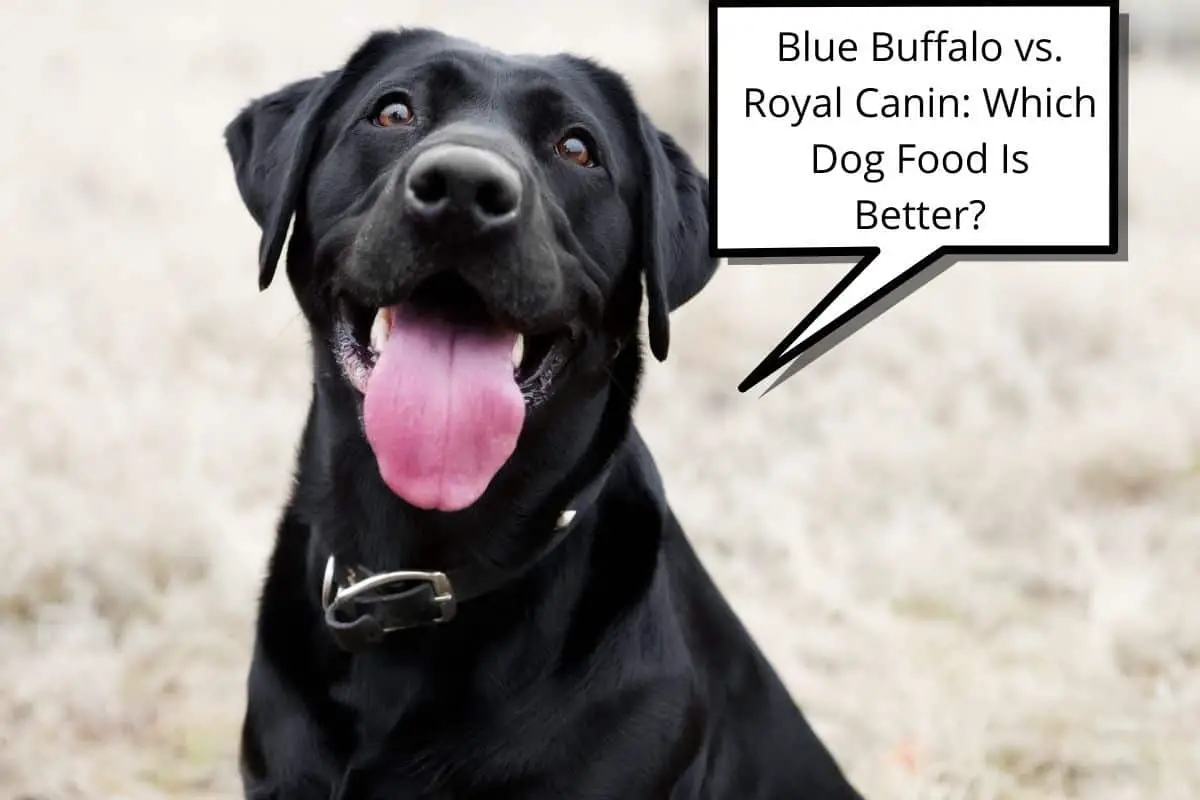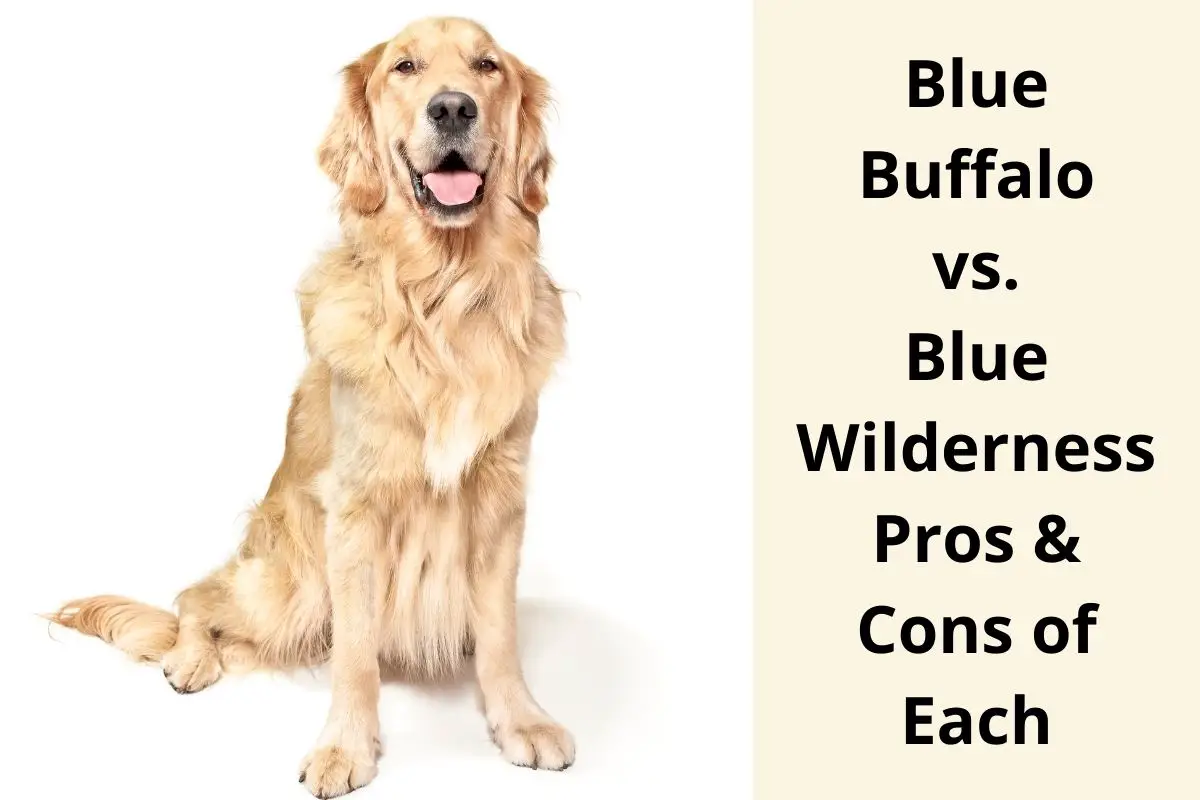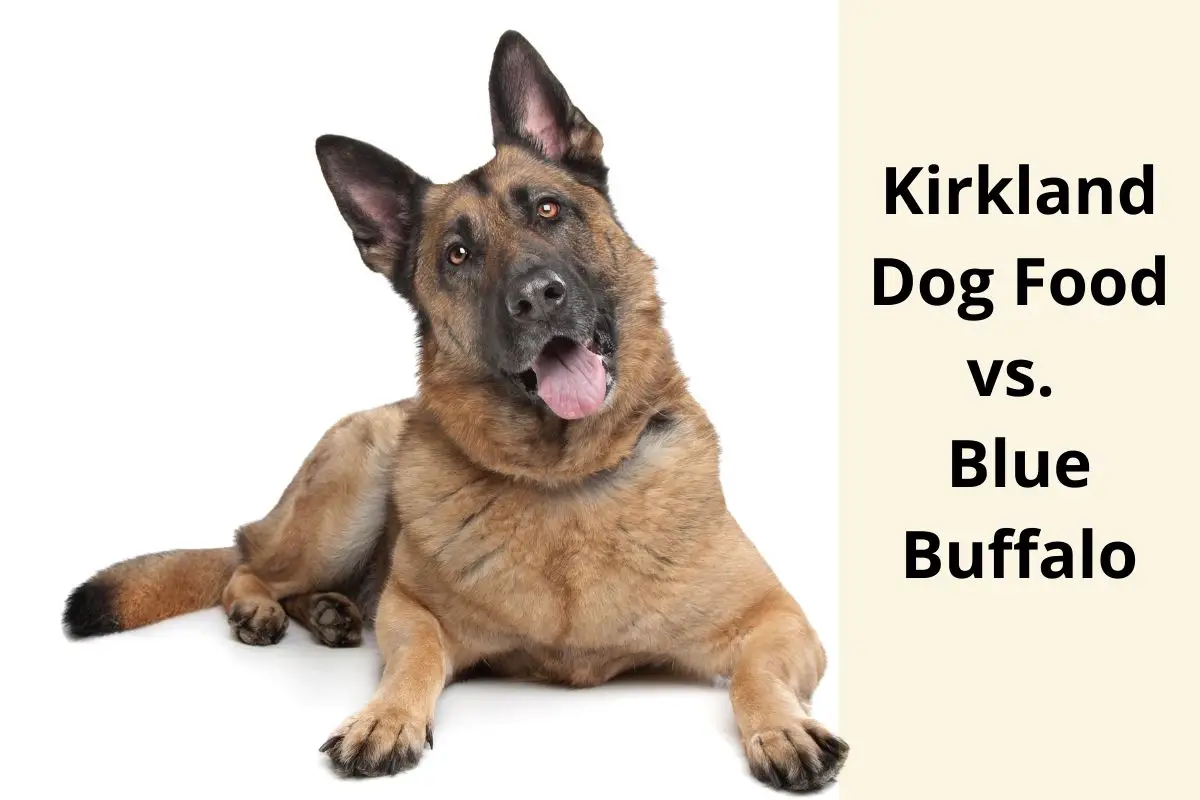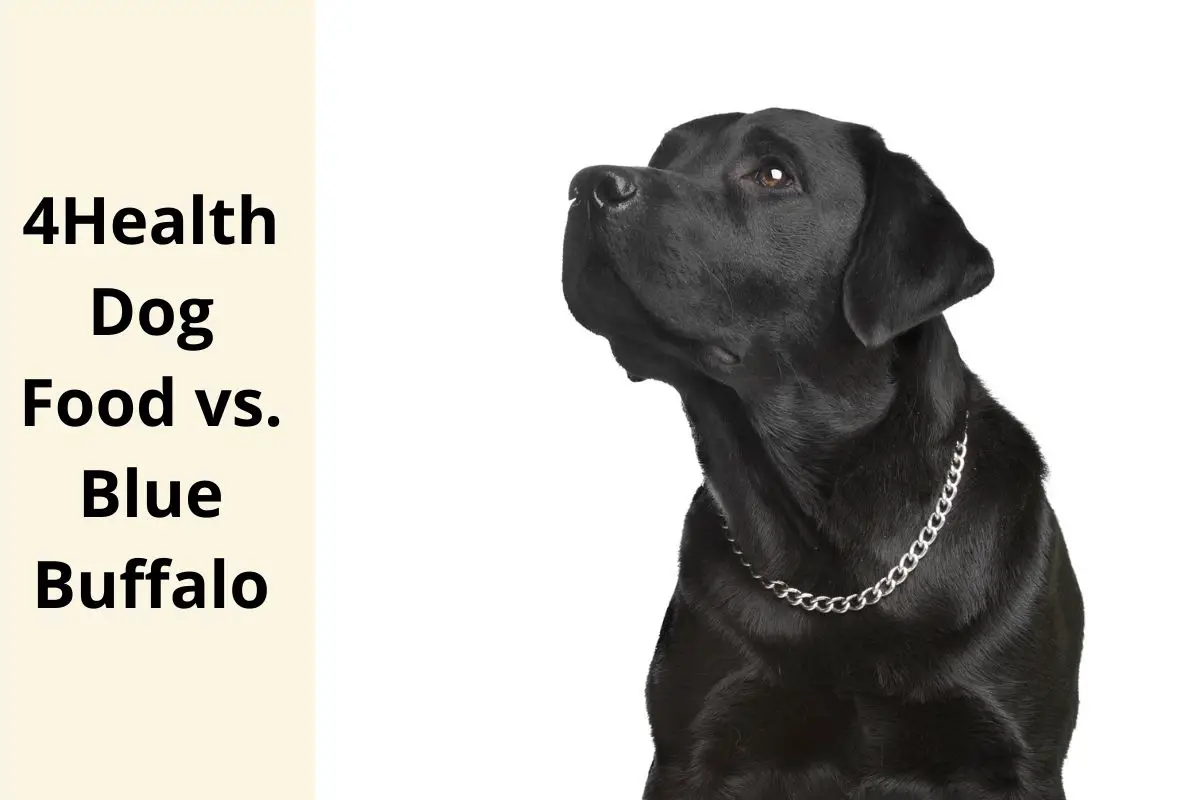This post contains affiliate links.
Responsible pet owners want their pets to thrive and live long, happy, healthy lives; the first step to ensuring good health and longevity is finding proper nutrition. With hundreds of dog food brands and thousands of formulas on the market, finding the perfect dog food (and one that Fido likes) is a challenge. Among these are Blue Buffalo and Royal Canin, but which one is right for your dog?
Blue Buffalo is the better choice if you want a reasonably priced, grain-free dog food that focuses on quality animal products as the primary source of protein in their foods. However, if you want grain-inclusive formulas and a breed-specific diet, go for Royal Canin, though it’s pricier.
In this guide, we’ll explore both Blue Buffalo and Royal Canin and dive into three different formulas from each. We’ll examine what makes each recipe great and what makes them controversial. By the end, we’ll break down the ingredients and nutrients from each brand to help you decide once and for all: is Blue Buffalo or Royal Canin better?
Table of Contents
Blue Buffalo vs. Royal Canin: Basic Similarities
Blue Buffalo and Royal Canin are two very different brands, owned by two very different companies. Yet, they do share a few similarities. So, before we dive into their specific formulas, ingredients, and nutritional profiles, let’s discuss what they have in common.
Both Blue Buffalo and Royal Canin carry dog food formulas with chicken as the main meat protein. But it’s not the same chicken you eat around the dinner table. In dog food, this chicken comes in quite a few forms, including:
- Raw chicken
- Deboned chicken
- Dried chicken
- Chicken meal
- Chicken by-product meal
All of these ingredients count as “quality meat-proteins” for canines except for chicken by-product meal. We’ll discuss this one a little more later when we get into the ingredients section!
The two brands also launched grain-inclusive recipes to keep up with modern trends. Yet, both approach the issue from two wildly different viewpoints. Blue Buffalo puts a heavy focus on grain-free while Royal Canin includes grains in almost all of its formulas.
Unfortunately, both brands have troubled pasts, at least in the recall department. In 2007, the FDA recalled dozens of foods for melamine contamination, affecting both Blue Buffalo and Royal Canin formulas. Blue Buffalo and Royal Canin also suffered another recall-related blow, recalling some recipes for excess Vitamin D levels.
We’ll discuss these recalls more in-depth at the end of this guide.
Blue Buffalo Pros & Cons
|
Pros |
Cons |
|
Grain-free and grain-inclusive recipes |
Recall history |
|
Meat is always the first ingredient |
Nutritional content varies widely |
|
Reasonably priced options |
Ingredient issues |
|
Manufactured in the USA | |
|
Majority of foods meet AAFCO standards |
Launched as a company in 2003, Blue Buffalo is still a relatively new dog food brand. Since the early days, the brand has experienced massive growth, and today, they’re one of the more popular dog food brands on the market.
While Blue Buffalo places a stern focus on grain-free formulas, they also feature grain-inclusive options (one of which we’ll discuss in this guide) in their recipe line-up.
This fact makes some concerned pet parents nervous. Rest assured, in either formula, meat is always the first ingredient. Whether it’s fish, chicken, turkey, lamb, or beef, every Blue Buffalo recipe packs a protein-rich punch!
Here’s the good news: you won’t find any cheap animal by-products in any of Blue Buffalo’s formulas, giving the brand a leg up against its lower-quality competition. Ingredients like “chicken by-product meal” or “animal by-product” are generic terms used to describe by-products that you’d normally toss out. Blue Buffalo is certainly wise to ditch these filler ingredients.
Price-wise, Blue Buffalo is somewhat expensive, although still less costly than Royal Canin. When you consider the quality of the ingredients, however, the price seems a bit more reasonable. There are also some more affordably-priced options in their line for pet owners on a budget.
Blue Buffalo is manufactured in the United States, based in Wilton, Connecticut. Yet, they boast multiple processing plants scattered across America. Manufactured in America, most of Blue Buffalo’s products meet the American Association of Feed Control Officials (AAFCO) standards for dog nutrient profiles.
Unfortunately, Blue Buffalo has quite a lengthy recall record. Here’s a list of some of their more serious recalls that stain their otherwise glowing reputation:
- March 2017: Elevated beef thyroid hormone
- February 2017: Possible metal contamination
- May 2016: Possible mold
- November 2015: Potential for salmonella
- October 2010: Potentially too much Vitamin D
- April 2007: Melamine
Blue Buffalo’s nutritional profiles vary widely from product to product. And you might notice a few controversial ingredients in their formulas, which we’ll discuss further throughout this guide.
Blue Buffalo Freedom Grain-Free Adult Beef
Blue Buffalo’s “Freedom” line features 12 different dry dog foods, as well as some canned food options. This grain-free line contains no chicken by-product meals, artificial flavors, preservatives, corn, wheat, or soy, and each product is specially formulated for different ages and sizes.
|
Pros |
Cons |
|
Grain-Free |
Contains Dried Tomato Pomace |
|
Multiple Animal-Based Proteins |
Contains Peas and Pea Protein |
|
Contains Omega Fatty Acids | |
|
Contains Antioxidants | |
|
Meets AAFCO Nutrient Profiles |
Let’s take a closer look at one product from the Freedom Line — the Freedom Grain-Free Adult Beef Recipe — a grain-free dry dog food boasting impressive animal-based proteins.
Nutritional Information
- Carbohydrates: 49% (Estimated)
- Protein: 24%
- Fat: 14%
- Fiber: 6%
- Moisture: 10%
Key Ingredients
Deboned beef, turkey meal, potatoes, peas, pea starch, potato starch, chicken fat (preserved with mixed tocopherols), pea protein, dried tomato pomace, flaxseed, natural flavor, chicken meal, tapioca starch, dehydrated alfalfa meal, salt, choline chloride, dried chicory root
As with all of Blue Buffalo’s recipes, the first ingredient is a meat product. While it might sound funky, deboned beef is a quality ingredient! However, because the meat is processed before dog food production, it loses most of its moisture content. In other words, this recipe’s beef may only make up a small portion of a dog’s dinner, even though it’s the first ingredient on the list.
Fortunately, Blue Buffalo has several animal products in this formula, making it animal-protein dominant. The second ingredient is turkey meal, which counts as a “meat concentrate.” All that means is it’s higher in protein than fresh turkey and more easily digestible.
You’ll also find flaxseed — a good source of omega-3 and omega-6 fatty acids — in this formula. This high-quality additive contributes to a pup’s healthy skin and coat year-round.
“LifeSource Bits” are Blue Buffalo’s patented blend of vitamins, antioxidants, and minerals that coat the kibble. Antioxidants, in general, are found in many high-quality dog foods.
Also, Blue Buffalo’s Freedom Grain-Free Adult Beef Recipe meets AAFCO nutrient profile standards; add that to the “pros” list!
Unfortunately, potatoes are a prominent ingredient in this formula. Despite being a gluten-free carbohydrate source, potatoes in dog food are rather controversial. Additionally, this recipe contains peas and pea starch. So, not only do both of these ingredients provide little nutrition for a dog (it’s mostly fillers), but the FDA is investigating dog foods containing potatoes and legumes as a possible cause of canine dilated cardiomyopathy (DCM).
Blue Buffalo’s Freedom Grain-Free Adult Beef Recipe also contains dried tomato pomace, made with tomatoes’ leftover skin and seeds after processing. It’s another controversial ingredient with little nutritional value and considered an unnecessary filler for most canines because the skin of tomatoes is often laden with pesticide residue, and the seeds show even higher levels of pesticide residue, as they’re not processed.
Blue Buffalo Blue Wilderness Salmon With Grains
Blue Buffalo’s Wilderness line has 32 different formulas, including grain-free and grain-inclusive recipes. Some options are specifically formulated for different sized dogs, whereas others target specific age ranges (i.e., puppy, senior, etc.).
These are meat-rich, high-protein meals that contain no wheat, soy, or corn.
|
Pros |
Cons |
|
High-Protein Salmon |
Contains Potatoes & Sweet Potatoes |
|
High-Protein Chicken |
Contains Dried Tomato Pomace |
|
Contains Omega Fatty Acids |
Contains Peas & Pea Starch |
|
Contains Antioxidants | |
|
Meets AAFCO Nutrient Profiles |
Now, we’ll take a look at a product from the Wilderness line: Blue Buffalo Wilderness Salmon with Grains. This grain-inclusive formula infuses several animal products for protein and meets AAFCO nutrient profile standards.
Nutritional Information
- Carbohydrates: 38% (Estimated)
- Protein: 34%
- Fat: 15%
- Fiber: 6%
- Moisture: 10%
Key Ingredients
Deboned salmon, Menhaden fish meal, chicken meal, dried chicken, oatmeal, barley, potatoes, dried tomato pomace, dried egg product, chicken fat (preserved with mixed tocopherols), natural flavor, sweet potatoes, peas, pea protein, potato starch, flaxseed, dehydrated alfalfa meal
Deboned salmon is the first ingredient on the list, making this food an excellent source of omega-3 fatty acids. Once salmon is processed, however, it loses a lot of its weight. In other words, your pup may not have as much salmon in his bowl as the label suggests.
Menhaden fish meal is another animal protein high in omega-3 fatty acids. Like all animal meals, fish meal is a meat concentrate made by drying the fish, baking what’s left, and creating a protein powder. This somewhat rare ingredient delivers even more protein than raw fish, which works wonders for growing dogs.
As with all of Blue Buffalo’s recipes, antioxidants are included in the kibble in the form of their patented LifeSource Bits.
However, this recipe is different from many of Blue Buffalo’s other formulas. By that, we mean it contains grains — specifically oatmeal and barley — which are cereal grains. And while they do have some vitamins and fiber, they’re not considered nutritionally valuable to canines.
In addition, this recipe includes tomato pomace (an unnecessary filler), peas, potatoes, and sweet potatoes. As mentioned in the previous section, dog foods containing potatoes, sweet potatoes, and legumes may be a potential risk factor for DCM.
Blue Buffalo Life Protection Chicken & Brown Rice for Puppies
Blue Buffalo’s Life Protection line has four different formulas, including:
- Puppy Chicken & Brown Rice
- Puppy Lamb & Oatmeal
- Small Breed Puppy Chicken & Oatmeal
- Large Breed Puppy Chicken & Brown Rice
Every product in the Life Protection line is grain-inclusive.
|
Pros |
Cons |
|
High-Protein Chicken |
Contains Peas and Pea Protein |
|
Contains Fish Oil for Omega Fatty Acids |
Contains Tomato Pomace |
|
Small Kibble for Puppies | |
|
Contains Antioxidants | |
|
Meets AAFCO Nutrient Profiles |
Let’s take a quick look at the Blue Buffalo Life Protection Chicken & Brown Rice Puppy formula.
Nutritional Information
- Carbohydrates: 43.5% (Estimated)
- Protein: 27%
- Fat: 16%
- Fiber: 5%
- Moisture: 10%
Key Ingredients
Deboned chicken, chicken meal, brown rice, oatmeal, barley, Menhaden fish meal, peas, chicken fat (preserved with tocopherols), flaxseed, natural flavor, dried tomato pomace, dried egg product, pea protein, fish oil
Its first and second ingredients are, once again, quality animal proteins, this time deboned chicken and chicken meal (a valuable source of concentrated protein). Chicken meal is considered a valuable source of concentrated protein.
The added fish oil provides puppies with omega fatty acids that are essential for early growth and development. The small kibble makes this recipe ideal for puppies to chew as they begin their dry dog food journey. And the probiotics from the LifeSource Bits can guarantee healthy digestion.
Like all Blue Buffalo formulas, the Blue Buffalo Life Protection Chicken & Brown Rice Puppy recipe meets AAFCO nutrient profile standards.
While this formula is a good option for puppies, it does offer some questionable ingredients:
- Brown rice is a whole grain and complex carbohydrate. This grain is easy to digest once cooked but isn’t nutritionally valuable to a dog, aside from its caloric content.
- Oatmeal and barley are cereal grains. They contain fiber but are considered only “average” in terms of nutritional value.
- Legumes (peas) and potatoes are also in this recipe. Again, the FDA is investigating a potential link between dog food containing legumes and potatoes and DCM.
- Dried tomato pomace is a filler product and considered non-nutritious.
Despite its mildly controversial ingredients, Blue Buffalo’s Life Protection Chicken & Brown Rice Puppy formula is a decent option for most growing dogs!
Royal Canin Pros & Cons
|
Pros |
Cons |
|
Well-Established Brand |
Ingredient Issues |
|
Veterinary and Breed-Specific Diets Available |
No Grain-Free Options |
|
Broad Product Range |
Pricier Than Other Brands |
|
Widely Available Product | |
|
Pea-Free Recipes |
Royal Canin is a dog food brand that has some longevity to its name. Founded in 1968, this brand knows its way around the dog food industry. They have research centers and factory locations worldwide, and their products typically have a spot on a shelf in veterinary offices.
The defining feature that makes Royal Canin “unique” is its breed-specific diets. However, the recipes are seemingly endless — different ages, exercise levels, sizes, and more. They have a broad product range, including retail and vet-exclusive products, available on the market.
A grain-inclusive brand, Royal Canin infuses various protein sources in their dog food recipes, including plant proteins. The bummer is that there are no grain-free options available just yet. Not surprisingly, this missing option may turn away pet owners looking for grain-free diets. But many of Royal Canin’s products are pea-free, whereas Blue Buffalo uses peas in almost all its formulas.
On the cons side, many of Royal Canin’s recipes don’t meet AAFCO nutrient guidelines standards. Of course, Royal Canin has an explanation for that: they’re a nutrient-driven brand that focuses more on nutritional values than ingredients.
But like Blue Buffalo, Royal Canin is no stranger to dog food recalls, including:
- May 2007: Melamine
- April 2007: Melamine
- February 2006: Too much Vitamin D3
Another downside to Royal Canin is the inflated price tag. Some of the formulas are only available via a vet’s prescription, meaning you might not be able to buy them without a vet visit.
Royal Canin Size Health Nutrition Medium Adult Dry Dog Food
Royal Canin’s Size Health Nutrition line contains different formulas for different sized dogs, including giant, large, medium, small, and extra small. Keep in mind that all products in this line are grain-inclusive.
|
Pros |
Cons |
|
High-Protein Chicken |
Contains Brewers Rice |
|
Contains Omega Fatty Acids |
Contains Wheat |
|
Contains Chelated Minerals |
Contains Vegetable Oil |
|
Variety of Foods Based on Dog’s Size |
No Probiotics |
|
Pea Free |
Not Recognized By AAFCO |
Let’s look a little closer at the Royal Canin Size Health Nutrition Medium Adult Dry Dog Food.
Nutritional Information
- Carbohydrates: 53%
- Protein: 23%
- Fat: 12%
- Fiber: 3.2%
- Moisture: 10%
Key Ingredients
Brewers rice, chicken by-product meal, wheat, corn gluten meal, chicken fat, natural flavors, dried plain beet pulp, oat groats, wheat gluten, fish oil, potassium chloride, calcium carbonate, psyllium seed husk, vegetable oil
This grain-inclusive recipe features brewers rice as the first ingredient. Now, you might be wondering what that means. Well, brewers rice is what’s left after whole grain rice is processed.
It’s a by-product, which is a low-quality ingredient, as mentioned above. Brewers rice also doesn’t provide much in the way of nutrition for dogs. Grain as a primary ingredient may turn off pet owners looking for quality dog food. However, those looking for grain-inclusive recipes might find the grains to be a perk.
Unfortunately, the second ingredient is a chicken by-product. While chicken itself is a quality ingredient, by-products are far different than raw chicken.
On the plus side, the recipe features chicken fat that contains protein and omega fatty acids. The extra fish oil only adds more omegas to Royal Canin’s recipes.
Finally, this recipe is pea-free and contains chelated minerals, which are easier to absorb as they’re combined with amino acids to form complexes. Yes, this is considered a quality additive.
The main cons of this product are the inclusion of wheat, vegetable oil, and the lack of probiotics:
- Wheat isn’t nutritionally valuable to a dog. It does provide energy in the way of caloric content, but other than that, it’s nothing more than a filler ingredient.
- Vegetable oil is a vague term and could mean oil from any vegetables sourced from literally anywhere. Because it’s non-specific, it’s hard to say whether this is a quality ingredient or not.
- Probiotics, which help with digestion, are nowhere to be found in this food.
This grain-inclusive food is available at retail stores and online, but it doesn’t meet AAFCO nutrient profile standards.
Royal Canin Selected Protein PR Dry Dog Food
Royal Canin’s veterinary-exclusive line contains over a dozen products, including health (i.e., renal health formulas, gastrointestinal recipes, etc.) and size-based dog foods. This line is only available by prescription at your veterinarian’s office.
|
Pros |
Cons |
|
Limited Ingredients |
Not Recognized by AAFCO |
|
Contains Coconut Oil for Omega Fatty Acids |
Contains Potato Protein |
|
Contains Fish Oil |
Contains Vegetable Oil |
|
Contains Hydrolyzed Protein |
Veterinary Exclusive |
Here’s a better glimpse of the Royal Canin Selected Protein PR Dry Dog Food.
Nutritional Information
- Carbohydrates: 55%
- Protein: 19.5%
- Fat: 10.5%
- Fiber: 3.7%
- Moisture: 10%
Key Ingredients
Potato, rabbit meal, coconut oil, hydrolyzed soy protein, potato protein, natural flavors, vegetable oil, monocalcium phosphate, fish oil, calcium carbonate
Royal Canin’s Selected Protein PR Dry Dog Food is a limited-ingredient dog food, making it a good choice for dogs with food sensitivities. That means owners can use this food as part of an elimination diet to determine which foods may be bothering their pooch. It’s part of a veterinary-exclusive diet, meaning you’d need a prescription from your vet to be eligible to buy it.
Here’s the bad news: potatoes are the first ingredient in this formula. While potatoes are a gluten-free source of carbohydrates, they don’t offer much nutritionally. Additionally, as we’ve mentioned throughout this guide, the FDA cautions against dog foods containing potatoes in the first ten ingredients, as it may be a potential risk factor for DCM.
Rabbit meal is the second ingredient. If you’re wondering: yes, rabbit meal is different from raw rabbit because it’s a concentrated protein source. It contains over 300% more protein, is low in fat, and is rich in vitamins and minerals.
Coconut and fish oil are nutritionally valuable and somewhat unique additions to this dog food. Both oils are rich in fatty acids. Coconut oil also contains medium-chain triglycerides (MCTs), and studies have shown that they’re beneficial to brain function in older dogs.
Royal Canin’s Selected Protein PR Dry Dog Food also incorporates plant proteins into this recipe. For example, hydrolyzed soy protein from soybeans offers plenty of amino acids and has hypoallergenic properties.
Unfortunately, this product also contains vegetable oil. Again, the term “vegetable oil” is very vague and doesn’t give us much to work with. We’d classify this as a questionable ingredient, but not inherently bad.
Like other Royal Canin products, this food doesn’t meet AAFCO nutrient profile standards.
The main downfall of this product is that it’s a pricey dog food that’s only available by prescription from a veterinarian and still doesn’t offer the best nutrition.
Royal Canin Large Puppy Dry Dog Food
Royal Canin’s vet-designed, grain-inclusive Large Puppy Dry Dog Food is formulated for large-breed puppies (i.e., German Shepherds, Rottweilers, etc.). This line offers recipes for different-sized puppies, and the ingredients vary slightly.
|
Pros |
Cons |
|
High-Protein Chicken |
Not Recognized by AAFCO |
|
Contains Fish Oil for Omega Fatty Acids |
Contains Corn |
|
Small Kibble for Puppies |
Contains Wheat and Wheat Gluten |
|
Contains Glucosamine |
Contains Vegetable Oil |
Let’s look at the Royal Canin Large Puppy Dry Dog Food.
Nutritional Information
- Carbohydrates: 45%
- Protein: 28%
- Fat: 14%
- Fiber: 3.5%
- Moisture: 10%
Key Ingredients
Corn, chicken by-product meal, wheat, wheat gluten, chicken fat, brewers rice, corn gluten meal, natural flavors, brewers rice flour, dried plain beet pulp, monocalcium phosphate, sodium silico aluminate, vegetable oil, fish oil, salt, psyllium seed husk, calcium carbonate
This recipe is designed specifically for puppies, with its smaller-sized kibble simplifying the feeding process for young canines.
Corn is an inexpensive ingredient found in dog food brands all over the market. It’s a controversial cereal grain that’s not considered nutritionally valuable compared to other grains because it has a relatively high glycemic index, making it a poor choice for dogs with blood sugar issues.
Corn is also a leading culprit behind food sensitivities and allergies in puppies. While corn itself isn’t a significant allergen, the storage mites that contaminate it could trigger an allergic reaction in your dog.
Chicken by-product meal is the second ingredient in Royal Canin Large Puppy Dry Dog Food. Unlike chicken meal, which is considered “clean” meat, chicken by-products contain parts of the chicken that you likely wouldn’t eat. Unfortunately, this food derives most of its meat protein from chicken by-product meal.
This formula somewhat redeems itself with chicken fat as the fifth ingredient and fish oil a little further down on the list. Chicken fat and fish oil are both high in omega fatty acids. Chicken fat is also a source of glucosamine, which is great for a puppy’s growing bones and joints.
Unfortunately, there are several controversial ingredients in this formula, including:
- Wheat
- Wheat Gluten
- Vegetable Oil
- Corn Gluten Meal
- Dried Beet Pulp
In keeping with the Royal Canin trend, this product doesn’t meet AAFCO nutrient profile standards.
Royal Canin Large Puppy Dry Dog Food may be a good option for puppies in terms of general nutritional content, but it’s far from perfect.
A Note on Blue Buffalo and Royal Canin Recall
On March 15, 2007, both Blue Buffalo and Royal Canin were mentioned in the United States Food and Drug Administration’s Melamine in Pet Food Recall. This recall followed over 300,000 phone calls from pet owners to the FDA. This issue was gut-wrenching: many pets died, while others suffered permanent kidney damage. The FDA’s investigation wound up being one of the largest dog food recalls in history.
The FDA investigation revealed that imported vegetable proteins contained melamine contaminants that killed pets and made others very ill. Eventually, charges were filed in the case. Many of the affected foods were pulled from the shelves, and some are no longer in production.
Both brands have also recalled foods for excess vitamin D levels.
The recall history of both brands is something to consider when choosing dog food for your canine.
Final Thoughts
While both Blue Buffalo and Royal Canin provide adequate nutrition for dogs, we’re going with Blue Buffalo as the better dog food. Blue Buffalo has a decent-sized product range, affordable prices, both grain-free and grain-inclusive formulas, and uses quality ingredients. Their recipes incorporate more animal-based proteins, and their LifeSource Bits mean that antioxidants and probiotics are included in every food.
Finally, all of their recipes meet the nutritional profile standards of the AAFCO, inspiring confidence in dog owners.
Related Articles
- Blue Buffalo vs. Science Diet: Pros & Cons of Each Brand
- Blue Buffalo vs. Nutro: Pros & Cons of Both
- Fromm Dog Food vs. Blue Buffalo: Pros and Cons of Each Brand
- Merrick Dog Food vs. Blue Buffalo: Which Dog Food Is Best?
- Blue Buffalo vs. Iams: Which Dog Food Is Better?
- Purina vs. Blue Buffalo: Pros & Cons of Each Brand
- Royal Canin Glycobalance vs Diabetic: Pros & Cons of Both
Sources
- Blue Buffalo: General Mills Completes Acquisition of Blue Buffalo Pet Products
- Global News Wire: Blue Buffalo Voluntarily Recalls Food Due To Potential Health Risk
- Blue Buffalo: Blue News Articles – Blue Buffalo Homestyle Recipe Letter
- The Seattle Times: Blue Buffalo Recalls Batch of Dog Food
- Amazon: Blue Buffalo Freedom Grain Free Adult Beef
- FDA: Investigation Into Potential Link Between Canine Diets and DCM
- New York Times: Do Pesticides Get Into The Flesh of Fruits and Vegetables
- US National Library of Medicine: Effect Of Handling and Processing on Pesticide Residues in Foods
- Amazon: Blue Buffalo Blue Wilderness Salmon With Grains
- Amazon: Blue Buffalo Life Protection Chicken & Brown Rice for Puppies
- Amazon: Royal Canin Medium Breed Adult Dry Dog Food
- Royal Canin: Selected Protein PR Dry Dog Food
- US National Library of Medicine: Ketogenic Diet in Alzheimer’s Disease
- Amazon: Royal Canin Large Puppy Dry Dog Food
- Harvard.edu: Deconstructing the Regulatory Façade: Why Confused Consumers Feed Their Pets Ring Dings and Krispy Kremes
- Harvard.edu: Glycemic Index for 60+ Foods
- Tufts University – Clinical Nutrition Service: The Scoop on Storing Pet Food
- FDA: Melamine Pet Food Recall of 2007
- American Veterinary Medical Association: Dog Food Recalled for Excess Vitamin D
Mrdogfood.com is a participant in the Amazon Services LLC Associates Program, an affiliate advertising program designed to provide a means for sites to earn advertising fees by advertising and linking to Amazon.com. We also participate in other affiliate programs which compensate us for referring traffic.
